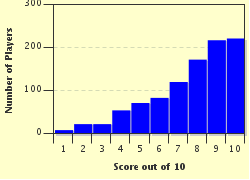Quiz Answer Key and Fun Facts
1. In 1942 and 1943, Hitler's fortunes changed when he lost this major battle in the USSR, one that had millions of military and civilian casualties.
2. What was Roosevelt trying to do with the Lend-Lease Act?
3. Who was the general that took over the American command in Africa, led the American landings in Sicily, saved the 101st Airborne at Bastogne, and commanded the 3rd army in Europe?
4. The Supreme Commander of Allied Forces in Europe and Africa directed the largest combined sea invasion in history on June 6, 1944, and announced its start by saying, "OK, we'll go." Who was it?
5. Who was it that promised to return to the Philippines as he left - right before they fell to the Japanese in 1942?
6. Who was the commander of the US Pacific Fleet whose island-to-island "leap-frogging" plan to win the war in the Pacific was central to the US success?
7. Who made the decision to drop the atomic bomb on Japan?
8. Which battle in the Pacific was most like the invasion of Normandy in its scope, size, number of ships used, and significance in bringing about an end to the war?
9. What was the name of the aircraft carrier versus aircraft carrier battle that was the key to stopping the Japanese advance toward Australia early in the war?
10. Why did Japanese military leaders choose to use kamikazis in battles like Leyte Gulf, Iwo Jima, and Okinawa?
Source: Author
nwehe
This quiz was reviewed by FunTrivia editor
bloomsby before going online.
Any errors found in FunTrivia content are routinely corrected through our feedback system.

